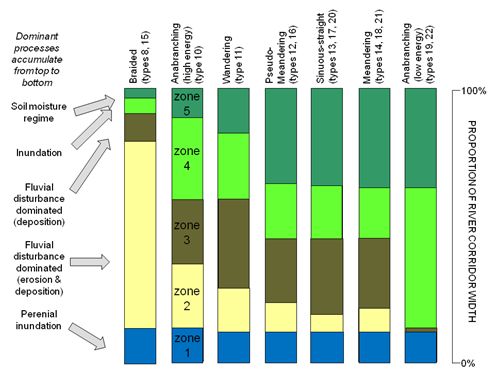In our 3rd newsletter, we highlighted the importance of adopting a hierarchical, multi-scale, approach to river hydromorphological assessment. We explained that this is important because the shape and behaviour of a river, as well as the landforms it creates and the habitats that it supports, are controlled by processes at a wide range of spatial scales. In other words, what we see within a river reach is the result of a cascade of influences from further upstream and downstream in the catchment. Information concerning the REFORM spatial hierarchical framework is now available as Deliverable 2.1, which is comprised of four volumes or parts: an overview of the framework (part 1); some more detailed discussion of some of its components (part 2); and two parts (3 and 4) illustrating applications of the framework to a selection of river catchments from different geographical areas of Europe. The four parts can be downloaded here.
Another crucial aspect of hydromorphology that is too often neglected, is the influence of vegetation on river channel form and dynamics. Riparian vegetation is not included as a biological quality element in the Water Framework Directive, and yet research conducted over the last 20 years has clearly shown that riparian vegetation has a fundamental influence on the hydromorphology of rivers and their floodplains, with a geographically more widespread impact than aquatic vegetation. Within the REFORM project, we have assembled evidence from published sources and available data sets to illustrate how vegetation interacts with hydromorphology to constrain numerous aspects of river morphology and dynamics, so providing a vital component of any river management and restoration efforts. Our findings are reported in Deliverable 2.2 part 1, which can also be downloaded here.
Here, we briefly focus on a conceptual model of vegetation-hydromorphology interactions that we have developed and tested in several catchments across Europe. The model highlights the natural functioning of vegetation as a control on river hydromorphology, indicating that if vegetation is heavily managed, the hydromorphological character of the river will change. If vegetation is allowed to colonise freely, it will accelerate river channel recovery from management interventions.
Vegetation interacts with hydromorphological processes. From one perspective, vegetation is constrained by hydromorphological processes that reflect the climate, moisture availability and physical disturbances to which the vegetation is subjected. These constraints operate over the different spatial scales of the hierarchical, multi-scale framework (Table 1). Against this background, vegetation within river channels and floodplains is very heavily affected by fluvial disturbances, such that only certain species can colonise the most disturbed parts of the river corridor.
Table 1: Hydromorphological processes and related factors reflecting climate , moisture availability and degree of fluvial disturbance, that constrain the plant species and communities that can occupy the spatial units found within river catchments.
|
Spatial scale |
Climate (Biogeographical context; Precipitation and Temperature) |
Moisture Availability (in addition to climate) |
Fluvial Disturbance |
|
Region |
Macrobioclimates |
|
|
|
Catchment |
Thermoclimatic belts |
Geology, Topography affecting water retention, deep percolation and aquifers |
Location, Geology, Topography affecting regional features (e.g. droughts, avalanches, mudflows) |
|
Landscape Unit |
Mesoclimate (Regional conditions due to elevation, topography) |
Geology, Topography and Soil condition, Land cover affecting water infiltration and moisture recharge/depletion |
Magnitude, frequency and duration of water and sediment delivery to the river corridor (e.g. magnitude and frequency of droughts, avalanches, mudflows, organic debris flows) |
|
Segment |
Meso-climate (Local conditions due to elevation, topographic orientation, form and setting) |
River-floodplain width, hillslope hydrology and river flow regimes. Segment-scale (alluvial aquifer) groundwater - surface water interactions (GSI) |
Valley gradient and river entrenchment: river flow and sediment transport regimes (e.g. frequency and duration of floods and droughts, sediment and plant material erosion, transport, storage) |
|
Reach |
Micro-climate (Local conditions due to wind, vegetation transpiration, water bodies evaporation,..) |
Cross sectional form and sedimentary structure, texture, permeability. Reach-scale GSI |
Channel gradient, size, type – morphology, bed and bank materials(calibre, cohesion, erodibility), stream power in relation to reach-scale water, sediment, plant material dynamics |
|
Geomorphic Unit |
Micro-climate (Point conditions due to vegetation shadow, water depth, updwellings, springs, velocity...) |
Microtopography, relative elevation, and distance relative to river bed. Sediment calibre, organic content, structure, and patch-scale GSI |
3D position with respect to active channel, erosion resistance and stability. |
Our conceptual model defines up to 5 zones that may be present within a river corridor (Figure 1):
- In moist environments, a zone of perennially-flowing water is present in the low flow channel (zone 1). Beyond this, the frequency, duration and depth of inundation decreases towards the outer limits of the river corridor (the outer edge of the floodplain and the base of bordering hillslopes).
- Within zone 2, inundation is frequent, deep, and prolonged, leading to relatively high flow velocities and shear stresses and so a high potential for the flowing water to erode, transport and deposit sediment and also to damage, uproot or bury plants.
- With increasing distance from the river (zone 3), inundation depth, duration and frequency decrease, reducing the potential for sediment erosion and transport, and leading to a progressive fining of transported and deposited sediment coupled with an increase in its organic content until, in zone 4, sediment dynamics are negligible during inundation.
- In zone 5, which includes the most elevated areas of the river corridor, and those that are most remote from the perennial channel, inundation is extremely rare and subsurface water dynamics become the dominant control on vegetation.
The relative size of these five zones varies greatly from river source to mouth and with the width of the river corridor. The relative proportions of the river corridor that the zones occupy also vary with the type of river that is being considered (Figure 2).
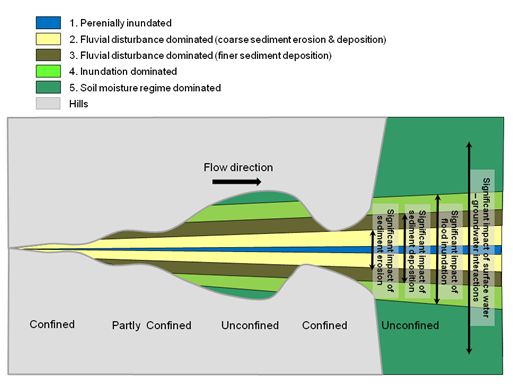
Figure 1: Schematic representation of the five zones of natural vegetation- hydromorphology interactions in river corridors of different confinement and width from the source to mouth of a river.
Figure 2: Schematic representation of the proportions of the width of a floodplain river corridor that may be occupied by the five zones of natural vegetation- hydromorphology interactions according to the type of river channel that is present.
These five zones are subject to different vegetation – hydromorphology interactions, and the nature of the interactions also varies according to the biogeographical region in which the river is located. However, in all cases, there is a critical zone of very tight and strong interactions that is important for understanding the consequences of vegetation management and recovery for river channel form and adjustment. This critical zone bridges river corridor zones 1 to 3 and is a zone where certain plant species can act as physical ecosystem engineers, colonising bare river sediment surfaces and then trapping transported sediments as the plants grow. In this way, the plants create landforms that can then be colonised by other plant species. Riparian tree species and rigid, emergent, aquatic plant species can often take on this role, and very large pieces of dead wood can often contribute by acting as retention structures for plant seeds and plant fragments that can sprout.
The engineer plants and the landforms that they create are located in the critical zone of intense plant-hydromorphology interactions, where they may be removed by the force of extreme floods but where they also colonise eroded areas and extend towards and into the channel during periods of less intense river flow disturbances. If these plants and any associated wood pieces are removed or cut back, this allows fluvial processes to push back the leading edge of the vegetation, increasing river bank erosion, widening the channel, and reducing the habitat complexity of the river channel and its riparian margins. In severe circumstances this can lead to a change in river type. For example, in extreme cases river channels have been observed to change from single thread to braided as a result of degradation of floodplain vegetation cover.
The photographs in Figures 3, 4 and 5 illustrate a small sample of the landforms that plants can create within the critical zone of the river corridor. The presence of such pioneer vegetated landforms, indicates the leading edge of vegetation-hydromorphology interactions that is so critical for river size and dynamics, and also for the diversity of the habitat mosaic that is available within the river ecosystem.
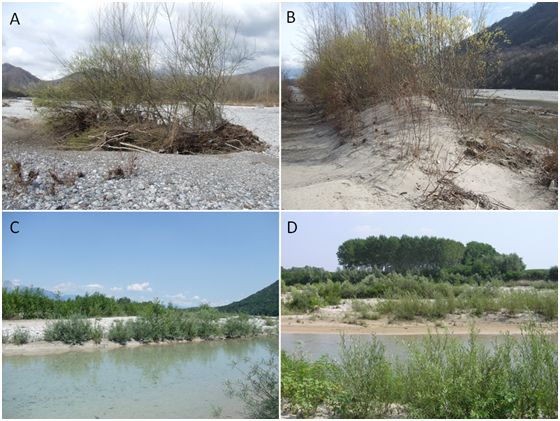
Figure 3: Early stage landforms built around sprouting uprooted trees, branches and tree seedlings. A. Pioneer island centred on a single uprooted and deposited tree. B. a building island which forms when a feature similar to A traps large quantities of fine sediment and grows through the sediment to form a large mound-like feature. C. a levee-like feature created by fine sediment accumulating around a line of tree seedling at the edge of the low flow channel. D. sprouting uprooted trees and branches trapping sediment and growing to give a sequence of ridges of increasing size and tree age parallel to the edge of the channel and usually on the inside of river bends (photos: Angela Gurnell).
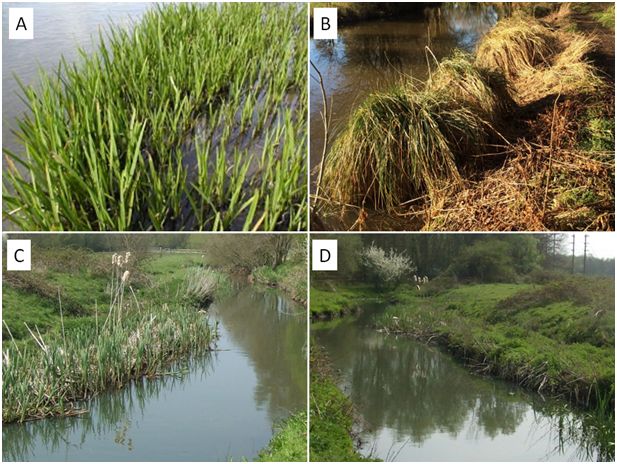
Figure 4: An evolutionary sequence of landforms created by emergent aquatic plants trapping and reinforcing fine sediment. A. a submerged shelf of fine sediment on the channel bed, formed around the base of a stand of aquatic plants. B. a submerged shelf, similar to A. but retained by tussock-forming aquatic plants. C. a berm formed by further sedimentation of features such as those in A and B, but now the sediment surface has aggraded to the low flow water surface level. D. a bench formed by further sedimentation of a berm feature such as that in C so that the surface is now located well above the low flow water surface level (photos: Angela Gurnell).
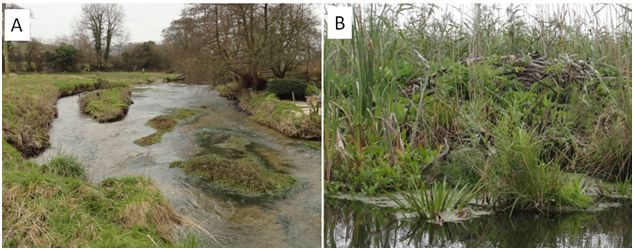
Figure 5: A. vegetated bars and islands created by sediment trapping and reinforcement by aquatic plants in a similar manner to the features shown in Figure 5. B. a river bank composed entirely of decaying plant material and reinforced by aquatic and wetland plants (photos: Angela Gurnell).

